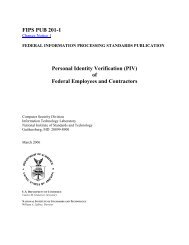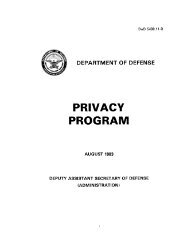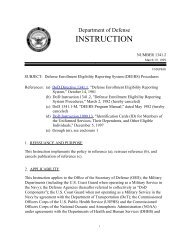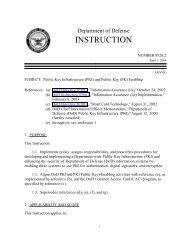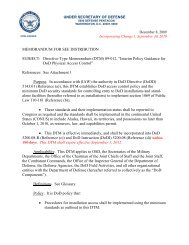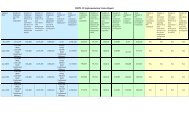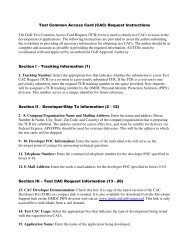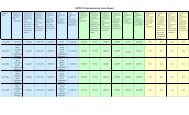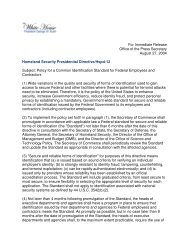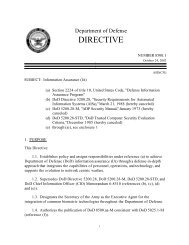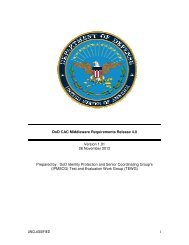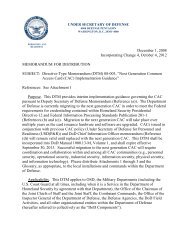DoD Instruction 8500.2 - Common Access Card (CAC)
DoD Instruction 8500.2 - Common Access Card (CAC)
DoD Instruction 8500.2 - Common Access Card (CAC)
You also want an ePaper? Increase the reach of your titles
YUMPU automatically turns print PDFs into web optimized ePapers that Google loves.
DODI <strong>8500.2</strong>, February 6, 2003<br />
Subject<br />
Area<br />
Control Number, Name and Text<br />
Enclave Boundary Defense<br />
EBRP-1<br />
Remote <strong>Access</strong> for Privileged Functions<br />
Remote access for privileged functions is discouraged, is permitted only for<br />
compelling operational needs, and is strictly controlled. In addition to EBRU-1,<br />
sessions employ security measures, such as a VPN with blocking mode enabled. A<br />
complete audit trail of each remote session is recorded, and the IAM/O reviews the log<br />
for every remote session.<br />
Enclave Boundary Defense<br />
EBRU-1<br />
Remote <strong>Access</strong> for User Functions<br />
All remote access to <strong>DoD</strong> information systems, to include telework access, is<br />
mediated through a managed access control point, such as a remote access server<br />
in a DMZ. Remote access always uses encryption to protect the confidentiality of the<br />
session. The session level encryption equals or exceeds the robustness established<br />
in ECCT. Authenticators are restricted to those that offer strong protection against<br />
spoofing. Information regarding remote access mechanisms (e.g., Internet address,<br />
dial-up connection telephone number) is protected.<br />
Physical and Environmental<br />
PECF-1<br />
<strong>Access</strong> to Computing Facilities<br />
Only authorized personnel with a need-to-know are granted physical access to<br />
computing facilities that process sensitive information or unclassified information that<br />
has not been cleared for release.<br />
Physical and Environmental<br />
PECS-1<br />
Clearing and Sanitizing<br />
All documents, equipment, and machine-readable media containing sensitive data are<br />
cleared and sanitized before being released outside of the Department of Defense<br />
according to <strong>DoD</strong> 5200.1-R and ASD(C3I) Memorandum, dated June 4, 2001, subject:<br />
"Disposition of Unclassified <strong>DoD</strong> Computer Hard Drives."<br />
Physical and Environmental<br />
PEDI-1<br />
Data Interception<br />
Devices that display or output classified or sensitive information in human-readable<br />
form are positioned to deter unauthorized individuals from reading the information.<br />
Physical and Environmental<br />
PEPF-1<br />
Physical Protection of Facilities<br />
Every physical access point to facilities housing workstations that process or display<br />
sensitive information or unclassified information that has not been cleared for release<br />
is controlled during working hours and guarded or locked during non-work hours.<br />
Physical and Environmental<br />
PEPS-1<br />
Physical Security Testing<br />
A facility penetration testing process is in place that includes periodic, unannounced<br />
attempts to penetrate key computing facilities.<br />
IA Service<br />
Confidentiality<br />
Confidentiality<br />
Confidentiality<br />
Confidentiality<br />
Confidentiality<br />
Confidentiality<br />
Confidentiality<br />
98 ENCLOSURE 4, ATTACHMENT 5



